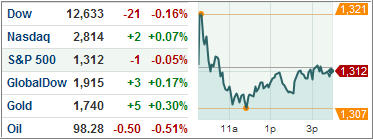There wasn’t much moving and shaking in the markets today despite a gloomy atmosphere in Europe. The S&P 500 dipped a mere 0.05%, but the index had its best January performance in 15 years, returning 4.36%. Although it might be The January Effect, please read my recent piece about the importance of a long-term outlook.
Once again, the 10-year yield fell, indicating a risk perception as investors fled to fixed income. Finishing the day at a yield of 1.80%, this is the lowest level in nearly 4 months.
The Greek finance minister has now alluded to a deal where bondholders may have to take a haircut in excess of 70 percent. This is surely a big potential setback from bondholders, but more importantly, it doesn’t mean that Greece’s debt issues will be solved regardless of whether or not it receives additional bailout funds.
As if Greece isn’t enough of a worry, Portugal is becoming an increasingly major concern. Its 10-year bonds are yielding an astronomical 17% while its debt-to-GDP is forecasted to be nearly 120% by 2013. Although a debt restructuring in Portugal might be possible, it would add severe strain on the Eurozone especially if Greece gets a second round of bailout funding.
To make matters worse in the Eurozone, the unemployment rate is now at 10.4% for the region. Not only is this troublesome in the wake of further austerity measures, but there is an increasing divergence between countries such as Germany with relatively low unemployment and countries like Spain, which has nearly 23% unemployment. If anything, the notion that more fiscally responsible nations will have to subsidize laggard Eurozone members will only heighten the tension.
Meanwhile, European banks have indicated they want to gobble up more ECB loans. While the banks absorbed nearly $650 billion in 3-year long-term refinancing options (LTROs) in December, persistent difficulties in the credit system might warrant more. With the ECB planning on giving out more loans in late February, there is speculation that banks might take on twice as much this time around.
The U.S. has its fair share of struggles to contend with as well. Economic data released today in the U.S. point toward lower consumer confidence in January as well as a decrease in business activity. Furthermore, the Standard & Poor’s/Case-Shiller Home Price Index fell in November from a year ago for the seventh straight month.
While January turned out to a better month than expected with the S&P 500 roughly 50 points above its 200-day MA, our Trend Tracking Indexes (TTIs) ended up as follows:
Domestic TTI: +4.30%
International TTI: -0.62%
Contact Ulli

Comments 2
I am sitting with a nice profit with VEU and VNQ. 8-10% range. With the market widely fluctuating, at what point would one consider taking profits and buying back later? I hate to see this disappear by having a 7% trailing stop should the market go down. I realize there may not be a perfect answer to this. Thanks for the excellent site.
Don,
You are right, there is no perfect answer. My preference is to use trailing sell stops as my signal when to take profits or limit losses, whichever case it may be. If you’re happy with your current gains and are worried about giving them back, simply take them.
Ulli…